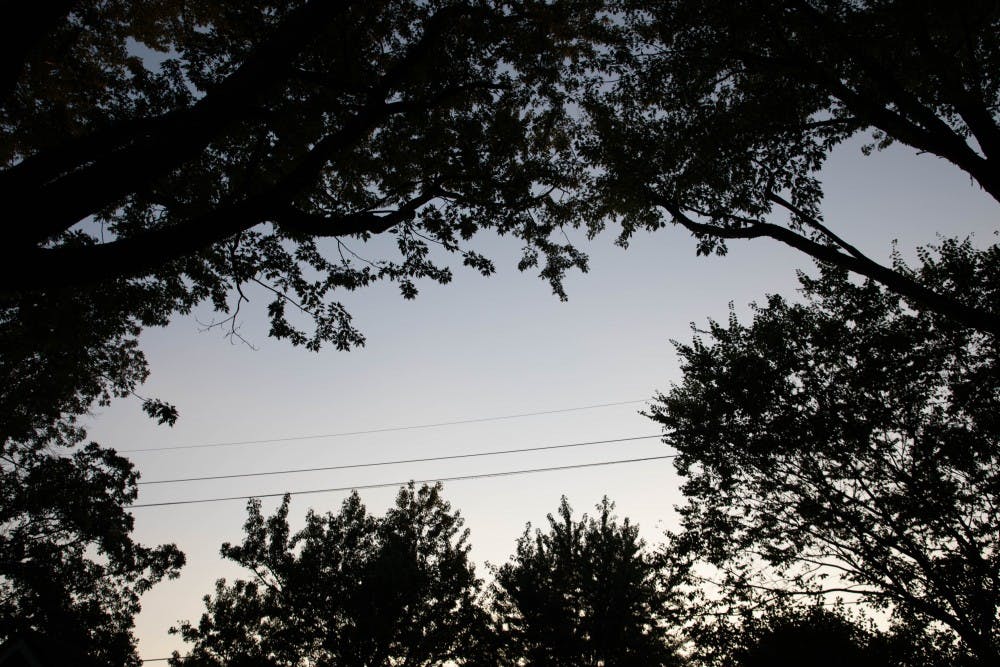“We have to be part of the solution. Otherwise, there won’t be a solution.”
David LeBlanc, professor of biology, and Michael Planton, associate director for landscape and environmental management, both believe the issue of deforestation is one overlooked not only by political leaders, but by general society as well.
“When you cut down a forest, all the carbon that was there is released back into the atmosphere,” LeBlanc said. “The problem isn’t about the carbon going into the atmosphere. The problem is the carbon that we are no longer taking out of the atmosphere.”
On average, every tree can store hundreds of pounds of carbon dioxide over the span of its lifetime, according to the U.S. Department of Agriculture’s website.
“The temperature under a tree is approximately 10 percent cooler than the temperature in the full sun,” Planton said. “Trees act as filtration systems for the dust and other airborne particles humans create. Unfortunately, people think there are enough trees.”
As a result, “deforestation accounted for about 12 percent of all human carbon dioxide emissions” as of 2008, an article on NASA’s Earth Observatory website said. The article also said these high amounts of carbon dioxide in the atmosphere result in “higher evaporation rates and a wetter atmosphere, which leads to a vicious cycle of further warming.”
The issue of deforestation is in many conversations right now because of the fires in the Amazon Rainforest. According to National Geographic, an estimated 7,000 square miles of the forest were burning as of Aug. 29.
As a solution to the issue of carbon pollution, people often believe planting trees in places they don’t currently exist is the answer, but LeBlanc disagrees.
Leblanc said that planting trees in improper areas like the Arctic or the Sahara Desert wouldn’t be countering the problem in a “meaningful way.”
“Some people are advocating for planting forests in places that forests don’t currently exist, and typically there’s not enough rainfall to support these trees in the area,” he said. “What happens is the trees will grow, but then they dry up the rivers.”
He also discouraged the attempt to convert agricultural land back into forests.
“Nobody's talking about turning cornfields back into trees because we need the corn, the world needs corn,” LeBlanc said. “Our population is going to increase to probably close to 10 billion, and we're going to need … more food than we currently produce if we're going to feed that population. So, we can't be converting productive agricultural land back to forest.”
Instead, LeBlanc suggests homeowners plant trees such as maple, tulip, oak, black gum and river birch in their backyards.
“The unfortunate thing about trees and cities is that it takes somebody with foresight 50 years ago for me to have a tree in my front yard [today,]” he said. “But, it takes me an hour of idiocy to have somebody come and cut it down. So, if you‘re not paying attention to it, it’s really much easier to lose trees than it is to gain them.”
Currently, Ball State has 10 common species on campus, as well as an arboretum to measure tree growth rates, the volume of carbon sequestered and the amount of stormwater filtered, Planton said.
The online database is used to “continue professional protection and care for existing trees and shrubs; continue planting and removing trees and shrubs as needed to maintain a safe and diverse urban forest that promotes learning,” according to the Ball State website.
“The arboretum is more than just trees. It comprises the entire campus and includes all the plants planted,” Planton said. “This makes it a living laboratory for classes ranging from art to landscape architecture.”
Through the use of the arboretum, Planton said, Ball State also watches the 65 ash trees it is currently treating, attempting to control the Emerald Ash Borer infestation.
He also added more than 700 trees were lost, but Ball State is using all of its time and resources to save as many as possible.
“People should pay forward,” Planton said. “If you only concern yourself with yourself then the world is doomed.”
Contact Chase Martin with comments at cgmartin@bsu.edu. Contact Taylor Smith with comments at tnsmith6@bsu.edu or on Twitter @taynsmithh.





